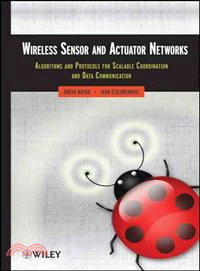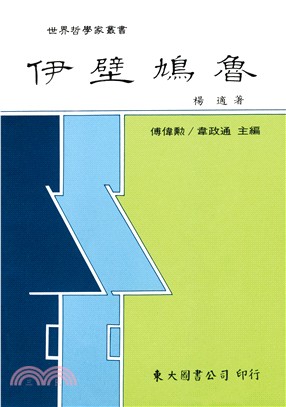WIRELESS SENSOR AND ACTUATOR NETWORKS:ALGORITHMS AND PROTOCOLS FOR SCALABLE COORDINATION AND DATA COMMUNICATION
商品資訊
商品簡介
The important new technology of wireless sensor and actuator networks provides radically new communication and networking paradigms with many new applications. Wireless Sensor and Actuator Networks is a timely text that presents a fault-tolerant, reliable, low-latency, and energy-aware framework for wireless sensor and actuator networks, enabling readers to fulfill the ultimate goals of the applications—such as protecting critical infrastructures, achieving timely emergency responses, and monitoring the environment. Taking a problem-oriented approach, this resource discusses a wide range of computing and communication problems and solutions that arise in rapidly emerging wireless sensor and actuator networks, striking a balance between theory and practice.
Discusses backbones as subsets of sensors or actuators that suffice for performing basic data communication operations or area sensing coverage
Surveys existing data communication schemes (broadcasting, routing, multicasting, anycasting, geocasting) for sensor-actuator coordination
Reviews the location service techniques
Addresses the problem of energy-efficient data gathering by mobile sinks/actuators
Describes protocols for coordination and topology control in sensor, actuator, and robot networks
Reviews existing solutions to the sensor placement problem in wireless sensor and actuator networks
This book is unique in that it addresses sensor and actuator networking in a comprehensive manner—covering all the aspects and providing up-to-date information—so that industry operators and academics from various areas can learn more about current networking trends, become aware of the possible architectures, and understand the advantages and limits in future commercial, social, and educational applications. Wireless Sensor and Actuator Networks is appropriate for graduate students in computer science, electrical engineering, and telecommunications, as well as practitioners working as engineers, programmers, and technologists.
作者簡介
IVAN STOJMENOVIC is currently editor in chief of four journals (including IEEE Transactions on Parallel and Distributed Systems). He has h-index 35 and over 5,000 citations. Stojmenovic was the recipient of the Royal Society Research Merit Award, UK, and the Excellence in Research Award of the University of Ottawa 2008–09. He has chaired and/or organized more than fifty workshops and conferences. He became an IEEE Fellow in 2008.
目次
Contributors.
1. Applications, Models, Problems, and Solution Strategies (Hai Liu, Amiya Nayak, and Ivan Stojmenovic).
1.1. Wireless Sensors.
1.2. Single-Hop Wireless Sensor Networks.
1.3. Multihop Wireless Sensor Networks.
1.4. Event-Driven, Periodic, and On-Demand Reporting.
1.5. Unit Disk Graph Modeling, Hop Count Metric, and Probabilistic Reception.
1.6. Adjustable Transmission Range and Power Metric.
1.7. Cost Metrics.
1.8. Sleep and Active State Modeling.
1.9. Architectures for Wireless Sensor and Actuator Networks.
1.10. Simple Models and Application of Wireless Sensor and Actuator Networks.
1.11. Generating Connected Wireless Sensor and Actuator Networks.
1.12. Generating Mobile Wireless Sensor and Actuator Networks.
1.13. Problems at Physical, MAC, and Transport Layers.
1.14. Problems at the Network Layer.
1.15. Localized Protocols as the Solution Framework.
1.16. Implementation of Sensor Motes.
1.17. Experiments On Test Beds.
1.18. Experiences with the Development of Sensor Network Systems.
References.
2. Energy-Efficient Backbones and Broadcasting in Sensor and Actuator Networks (Hai Liu, Amiya Nayak, and Ivan Stojmenovic).
2.1. Backbones.
2.2. Grid Partitioning-Based Backbones.
2.3. Clustering-Based Backbones.
2.4. Connected Dominating Sets as Backbones.
2.5. Overview of Broadcasting Techniques.
2.6. Physical Layer-Based Flooding, Neighbor Detection and Route Discovery.
2.7. Parameterless Broadcasting for Delay Tolerant-Networks.
2.8. Backbones and Broadcasting in Sensor–Actuator Networks.
2.9. RNG and LMST.
2.10. Minimal Energy Broadcasting.
References.
3. Sensor Area Coverage (Hai Liu, Amiya Nayak, and Ivan Stojmenovic).
3.1. Problems, Models, and Assumptions.
3.2. Coverage and Connectivity Criteria.
3.3. Area-Dominating Set Based Sensor Area Coverage Algorithm.
3.4. Asynchronous Sensor Area Coverage.
3.5. Synchronous Sensor Area Coverage.
3.6. Multicoverage By Sensors.
3.7. Physical Layer-Based Sensing, Protocols, and Case Studies.
3.8. Operation Range Assignment in WSANs.
References.
4. Geographic Routing in Wireless Sensor and Actuator Networks (Hai Liu, Amiya Nayak, and Ivan Stojmenovic).
4.1. Flooding-Based Routing and Georouting in Sensor Networks.
4.2. Greedy, Projection, and Direction-Based Routing.
4.3. Applications of Cost to Progress Ratio Framework to Georouting.
4.4. Memorization-Based Georouting with Guaranteed Delivery.
4.5. Guaranteed Delivery without Memorization.
4.6. Beaconless Georouting.
4.7. Georouting with Virtual and Tree Coordinates.
4.8. Georouting in Sensor and Actuator Networks.
4.9. Link Quality Metric in Sensor and Actuator Networks.
4.10. Physical Layer Aspects and Case Studies of Georouting.
References.
5. Multicasting, Geocasting, and Anycasting in Sensor and Actuator Networks (Arnaud Casteigts, Amiya Nayak, and Ivan Stojmenovic).
5.1. Multicasting.
5.2. Geocasting with Guaranteed Delivery.
5.3. Rate-Based Multicasting.
5.4. Anycasting with Guaranteed Delivery.
References.
6. Sink Mobility in Wireless Sensor Networks (Xu Li, Amiya Nayak, and Ivan Stojmenovic).
6.1. Introduction.
6.2. Energy Hole Problem.
6.3. Energy Efficiency by Sink Mobility.
6.4. Sink Mobility in Delay-Tolerant Networks.
6.5. Sink Mobility in Real-Time Networks.
References.
7. Topology Control in Sensor, Actuator, and Mobile Robot Networks (Arnaud Casteigts, Amiya Nayak, and Ivan Stojmenovic).
7.1. Introduction.
7.2. General Approaches In Static Sensor Networks.
7.3. The Minimum Spanning Tree.
7.4. Data Aggregation.
7.5. Spanning Trees in Uncontrolled Dynamic Topologies.
7.6. Detection of Critical Nodes and Links.
7.7. Biconnected Robot Team Movement for Sensor Deployment.
7.8. Augmentation Algorithm for Robot Self Deployment.
7.9. Biconnectivity From Connectivity without Additional Constraints.
7.10. Biconnectivity from Connectivity with Additional Constraints.
References.
8. Location Service in Sensor and Mobile Actuator Networks (Xu Li, Amiya Nayak, and Ivan Stojmenovic).
8.1. Introduction.
8.2. Classification of Location Services.
8.3. Location Update Policies.
8.4. Flooding-Based Algorithms.
8.5. Quorum-Based Algorithms.
8.6. Home-Based Approaches.
References.
9. Coordination in Sensor, Actuator, and Robot Networks (Hai Liu, Veljko Malbasa, Ivan Mezei, Amiya Nayak, and Ivan Stojmenovic).
9.1. Sensor-Actuator Coordination.
9.2. Task Assignment in Multirobot Systems.
9.3. Selecting Best Robot(s) when Communication Cost is Negligible.
9.4. Selecting Best Robot(s) with Nonnegligible Communication Costs.
9.5. Dynamic Task Assignment.
9.6. Deploying Sensors to Improve Connectivity.
9.7. Fault-Tolerant Semipassive Coordination Among Actuators.
9.8. Dispersion of Autonomous Mobile Robots.
9.9. Distributed Boundary Coverage by Robots.
9.10. Clustering Robot Swarms.
9.11. Robot Teams for Exploration and Mapping.
9.12. Coordinated Actuator Movement for Energy-Efficient Sensor Reporting.
9.13. Flying Robots.
References.
10. Sensor Placement in Sensor and Actuator Networks (Xu Li, Amiya Nayak, David Simplot-Ryl, and Ivan Stojmenovic).
10.1. Introduction.
10.2. Movement-Assisted Sensor Placement.
10.3. Mobile Sensor Migration.
10.4. Sensor Placement by Actuators.
10.5. Coverage Maintenance by Actuators.
10.6. Sensor Self-Deployment.
10.7. Sensor Relocation.
References.
Index.
主題書展
更多書展本週66折
您曾經瀏覽過的商品
購物須知
外文書商品之書封,為出版社提供之樣本。實際出貨商品,以出版社所提供之現有版本為主。部份書籍,因出版社供應狀況特殊,匯率將依實際狀況做調整。
無庫存之商品,在您完成訂單程序之後,將以空運的方式為你下單調貨。為了縮短等待的時間,建議您將外文書與其他商品分開下單,以獲得最快的取貨速度,平均調貨時間為1~2個月。
為了保護您的權益,「三民網路書店」提供會員七日商品鑑賞期(收到商品為起始日)。
若要辦理退貨,請在商品鑑賞期內寄回,且商品必須是全新狀態與完整包裝(商品、附件、發票、隨貨贈品等)否則恕不接受退貨。
























